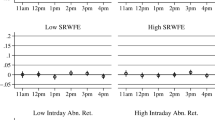Abstract
We hypothesize that the more central a firm in the customer–supplier network the lower is its returns from an acquisition. We find that the acquirers’ announcement day abnormal returns decline if the acquirer is more central in the network. Additionally, the target’s premiums decline if the target is more central in the network. Lastly, we also find that conditioned on the acquirer’s centrality, the acquirer’s announcement day abnormal returns increase if more information is available about the target. The centrality of the firm represents information availability of the firm. Thus, information availability may lead to a decline in acquisition returns.
Similar content being viewed by others
Notes
The data can be freely downloaded from: http://www.bea.gov/industry/io_benchmark.htm.
References
Aggarwal R, Baxamusa M (2013) Unrelated acquisition. AFA 2013 San Diego Meetings Paper
A’hern KR (2012) Bargaining power and industry dependence in mergers. J Financ Econ 103:530–550
Baxamusa M (2012) The relationship between underinvestment, overinvestment and CEO’s compensation. Rev Pac Basin Financ Mark Policies 15(3):1250014-1–1250014-26
Baxamusa M, Georgieva D (2013) Two step acquisitions and the liquidity spread. J Econ Finance 37(4). doi:10.1007/s12197-012-9247-6
Boone A, Mulherin J (2006) Do termination provisions truncate the takeover bidding process? Rev Financ Stud 20(2):461–489
Brass D (1984) Being in the right place: a structural analysis of individual influence in an organization. Admin Sci Quart 29:518–539
Burt R (1980) Models of network structure. Ann Rev Sociol 6(1):79–141
Burt R (2005) Brokerage and closure: an introduction to social capital. Oxford University Press, New York
Erickson M, Wang S, Frank Z (2011) Information uncertainty and acquirer wealth losses. SSRN abstract no. 1031544
Etheridge D (2010) Power and information: the effect of board networks on mergers and acquisitions. Finance and corporate governance conference paper. SSRN abstract no. 1536303
Fan J, Goel V (2006) On the patterns and wealth effects of vertical mergers. J Bus 79:877–902
Freeman L (1979) Centrality in social networks. Conceptual clarifications. Soc Netw 1:215–239
Granovetter M (1973) The strength of weak ties. Am J Sociol 78(6):1360–1380
Grossman S, Hart O (1980) Takeover bids, the free rider problem, and the theory of the corporation. Bell J Econ 11:253–270
Hong H, Scheinkman J, Xiong W (2006) Asset float and speculative bubbles. J Finance 61(3):1073–1117
Jensen M (1986) Agency costs of free cash flow, corporate finance, and takeovers. Am Econ Rev 76:323–329
Khanna N (1997) Optimal bidding for tender offers. J Financ Res 20:323–342
Kohers N, Kohers G, Kohers T (2007) Glamour, value, and the form of takeover. J Econ Bus 59:74–87
Krakhard D, Brass D (1994) Intra-organizational networks: the micro side. Advances in the social and behavioral sciences from social network analysis, pp 209–230
Lang L, Stulz R, Walking R (1989) Managerial performance, Tobin’s Q and gains from successful tender offers. J Financ Econ 24:137–154
Lawson T (1997) Economics and realty. London, Routedge
Lee S, Lim K (2006) The impact of M&A and joint ventures on the value of IT and non-IT firms. Rev Quant Financ Acc 27(2):111–123
Masulis R, Wang C, Xie F (2007) Corporate governance and acquirer returns. J Financ 62(4):1851–1889
Miller E (1977) Risk, uncertainty and divergence of opinion. J Financ 32:1151–1168
Moeller S, Schlingemann F, Stulz R (2004) Firm size and gains from acquisitions. J Financ Econ 73(2):201–228
Myers S, Majluf N (1984) Corporate financing and investment decisions when firms have information that investors do not have. J Financ Econ 13:187–221
Officer M, Poulsen A, Stegemoller M (2009) Target-firm information asymmetry and acquirer returns. Rev Financ Stud 13(3):467–493
P'astor L, Veronesi P (2006) Was there a Nasdaq bubble in the late 1990s? J Financ Econ 81:61–100
Povel P, Singh R (2006) Takeover contests with asymmetric bidders. Rev Financ Stud 19(4):1399–1431
Roll R (1986) The hubris hypotheses of corporate takeovers. J Bus 59:197–216
Schonlau R, Singh P (2009) Board networks and merger performance, Carnegie Mellon University working paper
Shahrur H (2005) Industry structure and horizontal takeovers: analysis of wealth effects of rivals, suppliers, and corporate customers. J Financ Econ 76:61–98
Travlos N (1987) Corporate takeover bids, methods of payment, and bidding firms’ stock returns. J Financ 42:943–963
Author information
Authors and Affiliations
Corresponding author
Appendix
Appendix
Centrality Measures (Definitions are based on network theory).
Degree Defined as the number of industries the nodal industry has supplier or customer relationships.
Eigenvector Each node in the industry network is assigned eigen values. Is the sum of the eigenvalues of the connections of the industry.
Closeness The farness of an industry is the sum of the shortest distance between the industry and all other connected industries. The inverse of farness is closeness. Cannot be calculated as a weighted centrality measure.
Betweenness Is the number of times the industry acts as the shortest path between two other industries. Cannot be calculated as a weighted centrality measure.
Degree Weighted Defined as the number of industries the nodal industry has supplier or customer relationships. Additionally, the number of ties is weighted by the total dollar flow between the two industries.
Eigenvector Each node in the industry network is assigned eigen values. Is the sum of the eigenvalues of the connections of the industry. Additionally, the number of ties is weighted by the total dollar flow between the two industries.
In-degree Is the fraction of the number of industries supplying to the nodal industry.
Out-degree Is the fraction of industries that are customers of the nodal industry.
Rights and permissions
About this article
Cite this article
Baxamusa, M., Javaid, S. & Harery, K. Network centrality and mergers. Rev Quant Finan Acc 44, 393–423 (2015). https://doi.org/10.1007/s11156-013-0411-7
Published:
Issue Date:
DOI: https://doi.org/10.1007/s11156-013-0411-7




